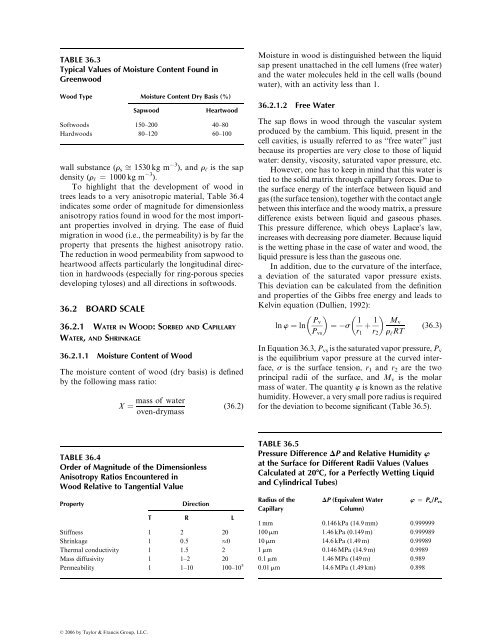36 Drying of Wood
36 Drying of Wood
36 Drying of Wood
- No tags were found...
You also want an ePaper? Increase the reach of your titles
YUMPU automatically turns print PDFs into web optimized ePapers that Google loves.
TABLE <strong>36</strong>.3Typical Values <strong>of</strong> Moisture Content Found inGreenwood<strong>Wood</strong> Type Moisture Content Dry Basis (%)wall substance (r s ffi 1530 kg m 3 ), and r ‘ is the sapdensity (r ‘ ¼ 1000 kg m 3 ).To highlight that the development <strong>of</strong> wood intrees leads to a very anisotropic material, Table <strong>36</strong>.4indicates some order <strong>of</strong> magnitude for dimensionlessanisotropy ratios found in wood for the most importantproperties involved in drying. The ease <strong>of</strong> fluidmigration in wood (i.e., the permeability) is by far theproperty that presents the highest anisotropy ratio.The reduction in wood permeability from sapwood toheartwood affects particularly the longitudinal directionin hardwoods (especially for ring-porous speciesdeveloping tyloses) and all directions in s<strong>of</strong>twoods.<strong>36</strong>.2 BOARD SCALE<strong>36</strong>.2.1 WATER IN WOOD: SORBED AND CAPILLARYWATER, AND SHRINKAGE<strong>36</strong>.2.1.1 Moisture Content <strong>of</strong> <strong>Wood</strong>The moisture content <strong>of</strong> wood (dry basis) is definedby the following mass ratio:X ¼Sapwoodmass <strong>of</strong> wateroven-drymassHeartwoodS<strong>of</strong>twoods 150–200 40–80Hardwoods 80–120 60–100(<strong>36</strong>:2)Moisture in wood is distinguished between the liquidsap present unattached in the cell lumens (free water)and the water molecules held in the cell walls (boundwater), with an activity less than 1.<strong>36</strong>.2.1.2 Free WaterThe sap flows in wood through the vascular systemproduced by the cambium. This liquid, present in thecell cavities, is usually referred to as ‘‘free water’’ justbecause its properties are very close to those <strong>of</strong> liquidwater: density, viscosity, saturated vapor pressure, etc.However,onehastokeepinmindthatthiswateristied to the solid matrix through capillary forces. Due tothe surface energy <strong>of</strong> the interface between liquid andgas (the surface tension), together with the contact anglebetween this interface and the woody matrix, a pressuredifference exists between liquid and gaseous phases.This pressure difference, which obeys Laplace’s law,increases with decreasing pore diameter. Because liquidis the wetting phase in the case <strong>of</strong> water and wood, theliquid pressure is less than the gaseous one.In addition, due to the curvature <strong>of</strong> the interface,a deviation <strong>of</strong> the saturated vapor pressure exists.This deviation can be calculated from the definitionand properties <strong>of</strong> the Gibbs free energy and leads toKelvin equation (Dullien, 1992):ln w ¼ lnP v¼ s 1 þ 1 Mv(<strong>36</strong>:3)P vs r 1 r 2 r ‘ RTIn Equation <strong>36</strong>.3, P vs is the saturated vapor pressure, P vis the equilibrium vapor pressure at the curved interface,s is the surface tension, r 1 and r 2 are the twoprincipal radii <strong>of</strong> the surface, and M v is the molarmass <strong>of</strong> water. The quantity w is known as the relativehumidity. However, a very small pore radius is requiredfor the deviation to become significant (Table <strong>36</strong>.5).TABLE <strong>36</strong>.5TABLE <strong>36</strong>.4Order <strong>of</strong> Magnitude <strong>of</strong> the DimensionlessAnisotropy Ratios Encountered in<strong>Wood</strong> Relative to Tangential ValuePropertyDirectionRadius <strong>of</strong> theCapillaryT R LStiffness 1 2 20Shrinkage 1 0.5 0Thermal conductivity 1 1.5 2Mass diffusivity 1 1–2 20Pressure Difference DP and Relative Humidity wat the Surface for Different Radii Values (ValuesCalculated at 208C, for a Perfectly Wetting Liquidand Cylindrical Tubes)DP (Equivalent WaterColumn)w ¼ P v /P vs1 mm 0.146 kPa (14.9 mm) 0.999999100 mm 1.46 kPa (0.149 m) 0.99998910 mm 14.6 kPa (1.49 m) 0.999891 mm 0.146 MPa (14.9 m) 0.99890.1 mm 1.46 MPa (149 m) 0.9890.01 mm 14.6 MPa (1.49 km) 0.898ß 2006 by Taylor & Francis Group, LLC.
















